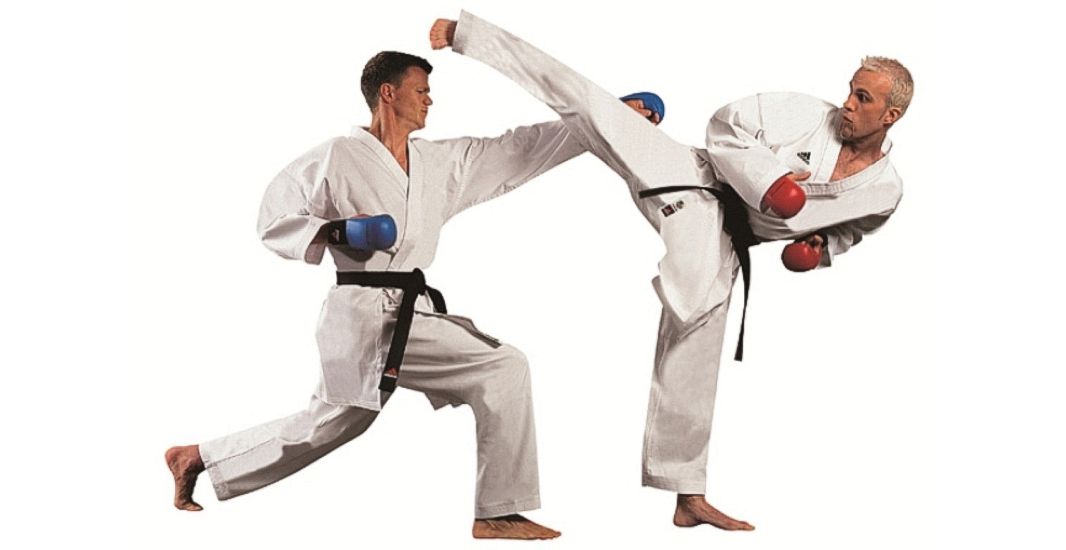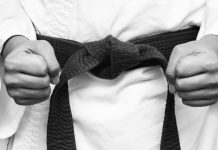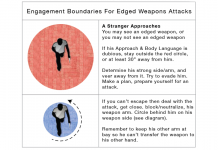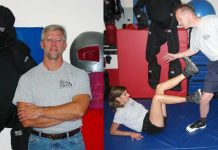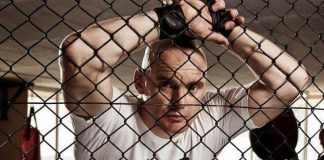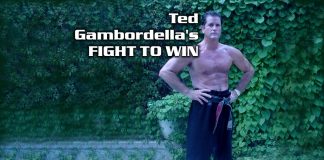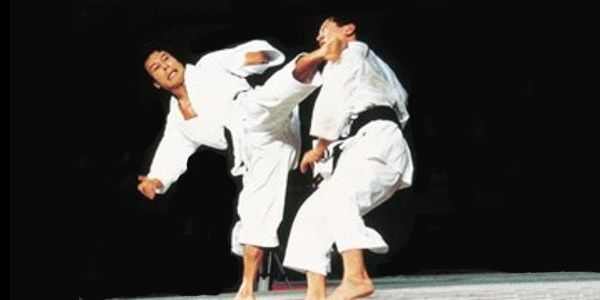 Sports karate and traditional fighting – is your Dojo’s curriculum working these synergistically? Why each evolved the way they did and why analysis makes them synergistic.
Sports karate and traditional fighting – is your Dojo’s curriculum working these synergistically? Why each evolved the way they did and why analysis makes them synergistic.
- Does your dojo have a check system (flow chart) for decision based training towards either dealing with an untrained attacker versus an elite karate athlete?
- Do you have a 1:1 link to your fighting training, kata form and bunkai in a way which also relates to tournament kumite performance?
- Do you engage in the correct tournament fighting approach, or street fighting approach when training?
The recent evolution in sports karate and research into rejuvenating karate bunkai has required schools to change training curriculum in order to be correct and effective in their fighting. Embracing the old and the new Ways is a difficult but necessary challenge to make ones’ karate a complete and educated empty handed fighting art. Understanding why modern day karate evolved (and realizing what was lost or gained) is a worthwhile journey. This article will overview some of the pros and cons of Dojo curriculum approaches for empty handed fighting. It will touch on: fighting practicality for a particular approach, diversity of knowledge base and training methods, a realistic check against why modern sport Karate differs compared to the traditional koryu and kata (bunkai) ways (such koryu styles include: various Okinawan arts, koryu-uchinadi, Daito-ryu, Matsushita Kushin Ryu, Araki-ryu).
Figure 1:
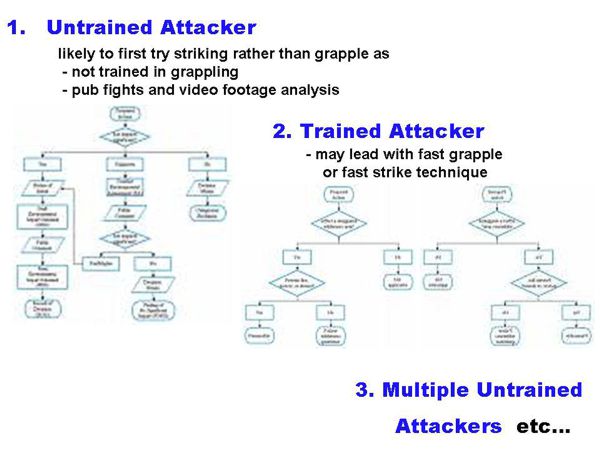
Most of the world’s Japanese karate community has evolved to where it is because of:
- a sports approach with rules
- starting a fight at distance away from the opponent
- training methods that allow the masses to follow in a group class
- use of a very small range of techniques (as discussed below approx. only 12 techniques or so are drilled in high frequency).
The notion of keeping the curriculum to a small subset of fighting techniques represents some of the benefits of one of Sun Tzu’s “Art of War” strategic clauses, “avoid weakness by not dividing the troops” i.e. do not become a “Jack of all trades and master of none”. The upside of this approach is that mastering one sub category of fighting leads to understanding true core strength which is not possible if studying a broad diversity of techniques. Hence Japanese styles keep the technique diversity very small, often even up to the rank level 3rd dan, so that only once a true understanding of real strength is reached in one area the study of other techniques are explored. The difference between superficial and deep insight (“ura” and “omote” are the Japanese terms used for this in the martial arts) is a key attribute of any Zen art. Modern day Japanese karate dojo(s) who have revived their kata bunkai knowledge to encompass original applications now have the complication of technique diversity compared to modern approaches seeking excellence in just a core few techniques (given that karate was adapted to the masses by the Japanese one can begin to see why the simplifications in curriculum began).
Real world fighting is not restricted by rules and does not assume one starts at a distance from at an opponent. In the street one does not know the strategy or skill level an opponent may employ. Before karate entered Japan Kata revolved around these self defense scenarios and also included:
- fluid, round and open hand techniques rather than the rigid stiff bunkai often seen in Japan which assumes a linear “karate style” punch as the primary entry in to the application.
- kata motions are iconic representations of a scenario not complete moves or descriptors. Modern variants in particular often do not show the various loosening techniques (head buts, spits and open hand slaps) that may comprise the full application which are still practiced by certain Koryu (old time/traditional) styles.
One can easily create a flow chart describing the possible scenarios (and the required skill sets to deal with an opponent). For example, Figure 1 (also on www.DownloadKarate.com in a free video form lecture) illustrates the initial questions in a thorough analysis of training approaches to focus on one sub-category of fighting or another to become an expert in that domain rather than becoming a generalist in all areas. Throughout this article an attempt is made to break down the needs to specialize in one area or another and then relate that to expanding your own training over time, or creating focused students.
Training philosophies that are” Jack of all trades” vs. “specialists in a subset of fighting” are often (but of course not always) seen more so in some styles than others. For example, grouping and comparing Kung-Fu, Koryu Okinawan Karate or Tae Kwon Do reveals a “Jack of all trades” approach compared to a modern Japanese Shotokan or Shito-Ryu approach which becomes highly proficient at a small set of techniques. Mainstream Japan’s karate approach is at the least related to the Japanese mainland mindset, its sports nature and Japanese Zen arts as they are practiced in Japan. Each of these variables influence any art/skill base and have pros and cons when it comes to critiquing a system.
To elaborate, as an example Shotokan dojo(s) often master a few techniques rather than a large diversity with only 15 or so regularly drilled techniques (front fist, reverse punch, back fist, front kick, side kick, roundhouse kick, back kick, oizuki, foot sweep and just a few more are done in extremely high repetition in any given training class). In comparison Tae Kwon Do & Kung Fu dojo(s) have a very large variety of kicks compared to what one would see in a Japanese mainland Shotokan dojo and often more hand technique types that Japanese karate. The nature of this article is not to state that one approach is better than another (as I do not believe that) but to awaken practitioners to the consequences of focusing one way or another in training and understanding the implications in terms of knowledge, or competency in a certain scenarios. After many years of study in one quality art, or another, a good 5th Dan equivalent in any of the arts may be equally dangerous and will have situations they are best trained for. However, there are often notable differences in the early stages of the paths up to 3rd Dan (or equivalent rank) in the given martial arts styles (again returning to technique diversity and even further spread by not limiting the curriculum to empty handed fighting but including weapons).
Figure 2 (also located on www.DownloadKarate.com) begins with a simple scenario involving an untrained attacker. Modern Japanese karate is designed for beginners to quickly comprehend and has evolved into something the masses can handle (which in part was forged by its introduction into schools in the early 1900s; see “Unante” authored by Sells 8th dan, ISBN 0-910704-96-1). Consequently it specializes in the following skills over a 3-4 year period:
1. getting out of the way of an attacker (ashi sabaki/tai sabaki)
2. blocking or receiving (uke)
3. countering
The above describes modern Japanese Karate, the original version of the art encompassed more than this from the word go. However, an important thing to realize is that the most likely scenario when a male is being attacked by an untrained male is that the lead technique will be a strike (as best stated by a website member of ours who had been a bouncer for 20 years, “just think of the bar fights you have witnessed and how the majority began – most of the time a swinging punch began the event”). This makes karate the ideal art for this scenario. Further evidence to suggest this is what will be attempted to begin a “male vs. untrained male fight” is based on at least the
following data:
1. Interviewing people (especially those exposed to bouncing in bars) as to what they recollect when they see a bar fight with 2 untrained males – rarely is the lead a gab/grapple as untrained people don’t do this well and they hesitate to get that close. Often when it goes to ground it is because someone:
a. was hit down
b. has lost balance evading
c. neither party could end the situation quickly with a strike so it went to ground
2. Interestingly even when one reviews the full contact UFC fighting the early seasons of this sport showed that grappling predominated and people were quick to surmise that “inevitably it will go to ground”. However one must consider the following:
a. after years of that sport now running later analysis of the individuals in the first few seasons of the sport were more commonly true experts in grappling with very few true experts in strike fighting participating
b. as the seasons evolved in to a 3rd or 4th year the majority of bouts ended not by “tap out” but by percussive impact i.e. a strike (as high as 70% of fights ended from a strike technique in the multiple tapes we reviewed). This seemed to be for two reasons:
i. more adept strike fighters got in to the league
ii. the strike fighters did not enter unless they had some basic competency in grappling (unlike their pre-cursors)
c. the gloves do take some of the edge off a blow compared to bare hands.
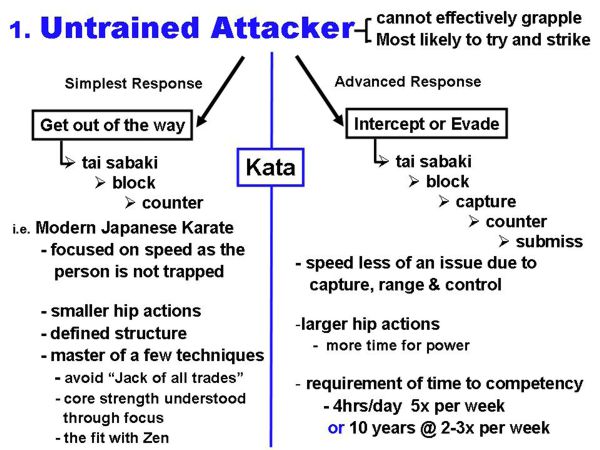
Figure 2:
Male on female assault is of course a different issue with around 70% of attacks beginning with a grab if one follows the statistics. So if a martial arts school has the aim to focus on street defense should females and males have different curriculums?
Returning now to modern Japanese fighting which is based around point fighting – even if it is considered to be impact oriented versus “tag oriented”. Dojo training for the most part presumes a strike as the lead technique. The abbreviated flow chart of Figure 2 touches on some of the bullets that result from this scenario and the training that therefore defines the art:
a. smaller hip actions (compared with Koryu discussed below)
i. necessary due to the required speed
ii. rotational power sacrificed for speed, and power also sacrificed for speed by keeping a constant body height (belt height) position
b. defined structure, techniques are simple combinations (at least on the surface)
i. extremely high repetition is practiced so create non-thought oriented muscle memory as no time to think exists (unlike a typical Koryu bunkai situation where a grapple/hold may give the combatant time to evaluate options mentally)
c. master of a few techniques avoiding a “Jack of all trades” approach.
i. A very Japanese Zen path – take one thing simplify it, understand it and practice it in incredible depth. When one looks at the Japanese Budo arts they are rarely arts that encompass many domains. For example, archery, judo, karate, kendo/iaido all only do one thing. They do not diversify (or dilute) the skill set which would be more typical of some Okinawan or Chinese arts which have weapons, striking and grappling domains all built in to one style.
ii. By focusing on just a few things one can truly understand mastery (the “ura” vs. “omote” in Japanese culture – touched on above in this article)
iii. Leaving out grappling and seizing (which we discuss in the advanced response (koryu section) one needs about 3 to 4 years of training at 3 times per week for an hour or so to become somewhat competent at:
1. evade
2. block
3. counter
i.e. Black Belt
Modern sports physiology has merged with sports karate to help that domain understand how to move faster, with more agility and powerfully. However, the sports community has to be careful about stating these are modern findings. For example, an often mentioned point these day by the sports karate community is the sports physiology research that reveals that contraction before expansion leads to a faster technique (in karate achieved by moving in stance before throwing a technique, or preceding one technique with a movement that contracts the muscles to be used in a following technique). These are all real and great uses of sports physiology data but the traditional karate arts have been talking about contraction-expansion in technique delivery for 100s of years. This is one very good example of the old facilitating the new and highlights why one should educate themselves in its time proven discoveries which are the basis of the art being practiced.
Many argue than the evolution of sports karate practitioners to fight from about 3 meters apart (up to 10 feet) is the result of age, talent, experience level and the rule based system. For example if starting so far apart makes so much sense to land a strike and protect oneself why does the very highly evolved technical and financial game of boxing not do the same? Being on the toes and moving has mobility and contraction expansion values, however, after all when one looks at the situation if you strike someone from 3m away you had to progressively more through the out of range 2 meter and 1 meter mark – why not just start at the 2 meter mark and go from there giving your opponent less time to read an incoming attack? The agility of young sports karate athletes allows them to do this and perhaps is a mechanism to overcome inadequacies in reading opponents and anticipation – attributes an older 5th dan with 20+ years of adult fighting may well have. However, so both the 25 year old elite sports karate-ka and the 40 year old elite karate-ka simply address a similar issue with different ways given their skill sets and physical capabilities. However, one can continue to learn from the other to better understand the art of fighting and themselves.
Many strategic combinations used in modern tournament fighting can also be extrapolated from good kata bunkai knowledge and such links between the dojo practices of kata, stratgey and technique should be fostered in clubs but unfortunately rarely is.
Moving beyond just “block counter”
In discussing Koryu karate we now move to side 2 of the flow diagram in Figure 2. The koryu karate arts of Okinawa represent their fighting approaches in kata with more of a one-to-one match of form to application (unlike modern Japanese karate where the forms are iconic and rarely represent the way they fight). These styles involve large hip actions, a larger variety of techniques, up and down motions to shift weight (belt height) coordinated with hip rotation for power generation and often larger style motions (not unlike what is often seen in Kung Fu).
Koryu is what we might call more classic street self defense as an approach – which has its drawback and advantages as a modern day art. In these scenarios we have an untrained male attacker (probably leading with a strike) and the series of responses is more complicated than that of the Modern Japanese karate practitioner in that in now aims to involve seizing and sub-missing. The downside of this in terms of likely success is that the more complicated anything is the more likely something will not pan out during the series of necessary steps. Additionally the approach requires someone to be far more skilled. One interpretation for this in karate dojo curriculums is to focus (but not restrict) training for those up to 2nd Dan to the modern Japanese approach rather than including all the capture/grapple and submission techniques. This will not dilute an early stage student and allow them to understand what reaching excellence really means by being very focused. In some of our closely associated dojo(s) in the Traditional Japanese Karate Network we have experimented with expanded kyu grade (colored belt) curriculums. The findings quickly show that the core of students and strong basics suffer relative to other mainstream dojo. On the other hand black belts above 3rd have many benefits to reap.
One key difference after executing a capture “Koryu” style (a kake uke following a given block with whiplash effect tug) is that the following counter can use a much large degree of hip and body weight as the opponent for a brief is being controlled and is a fraction disoriented. That is to say the speed of the punch/counter can be less than sports karate due to the circumstances allowing maximal impact.
This approach requires far more skill and time in training. Because of the diversity of technical knowledge required it generally does not suit your average person who just wants to practice 3 or 4 times a week for 1.5 hours. In fact most high ranked black belts (3rd dan and above) will struggle to maintain proficiency of such a diverse range of techniques to the “omote” level of speed, innate response and technical insight given the demands of balancing everyday; life, work and training.
How does an organization maintain such a board knowledge base with true insight into each subcategory of fighting?
One way to cope with the need of a karate style, or organization, to encompass each of the different segments of karate (e.g. sports, grappling, old school hard impact, kata, bunkai etc.) at the “omote” level of understanding and execution is to balance the organization with instructors of specializing domains. This is not unlike what the professional world does in training people. For example, when ones needs a doctor for a treatment different doctors exist for specific illnesses domains (i.e. specialists) for serious illness a “Jack of all trades” is not the answer.
The link that bridges all these skill sets, or variants of karate is Kata and the extrapolation of it then feeds out to each of the various sub categories of empty handed fighting.
As a final comment very few of us who practice karate will ever use its physical content. Therefore, one’s dojo should firstly focus on character development and mental development as these are things we are challenged with every day in life – using your dojo training to develop skills you know you will use should be a first priority.
A thank you to the key sensei who have contributed to my thoughts on the above topics: Sensei Sotokawa (Japan), Sensei Uetake (Japan), Sensei Morio Higaonna (Japan) Sensei John Sells (USA) Sensei John Bartholomay (USA), Sensei Patrick McCarthy (Australia), Sensei Victor Young (USA), Sensei Greg Story (Japan). Visits to a variety of dojo in Okinawa and Japan. A special thanks to Sensei John Bartholomay (USA) and Sensei Victor Young (USA) acting as editors on this article.

